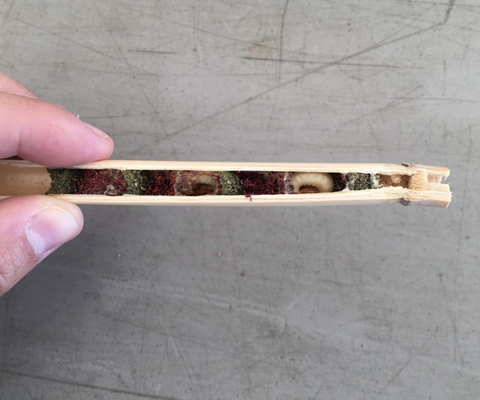Posted: October 17, 2021
IBC Education Specialist Heather Desorcie reports on this fall's solitary bee workshop, hosted by the Arboretum at Penn State

Larvae and undeveloped eggs with pollen rations are found inside a stem from the bee hotel at The Arboretum at Penn State
“Save the Bees” is a phrase that has gained popularity in response to global bee declines. It adorns everything from reusable tote bags to bumper stickers, and homeowners, businesses, and growers have taken action by planting native flowers and reducing pesticide use to protect these important pollinators. Perhaps you have done these things as well. But have you ever thought about running a hotel for the bees in your backyard? Participants at this fall’s Solitary Bee Workshop led by entomologist Dr. Natalie Boyle received a hands-on introduction on how to “bee” a hotelier.
What is a bee hotel?
90% of bee species are solitary, meaning they do not nest in a collective hive. Rather, a single female lays her eggs either in underground burrows or tree cavities. A bee hotel is made of hollow reeds or wood blocks with drilled holes, replicating natural cavities bees use for their brood.
Osmia mason bees, common inhabitants of bee hotels, have an annual life cycle. In the Spring, an adult female will mate and create several brood cells with mud or plant material inside a reed, each containing a ration of pollen and a single egg. Larvae will hatch from these eggs, consuming the pollen left by their mother. To prepare for their next life stage, larvae will defecate before spinning a cocoon made of silk fibers. It is in this state that the bees will spend the winter, developing into the adult bees we recognize in our gardens. When Spring arrives and the adult bees are mature, they chew their way through the mud partitions to free themselves from their nursery.
What is inside?
The first bee hotel that the participants opened was from the Russell E. Larson Agricultural Research Center in Rock Springs, where Japanese orchard bees (Osmia cornifrons) are used in place of commercial honey bees to pollinate orchards. Boyle demonstrated how to carefully break into the hollow reeds starting at the vestibule cell, a brood cell intentionally left empty by the mother bee at the reed entrance.
Inside were dozens of gray cocoons the size of small beans. Boyle explained, “Opening up and harvesting your cocoons can be an important part of good bee hotel stewardship. It allows you to better understand who your hotel guests are and can be a good way to survey your nests for destructive pests or parasites that might be lurking inside.”
The bee hotels in the Pollinator and Bird Garden at The Arboretum were opened next, and participants found all stages of a bee’s life cycle inside these stems. This is because many species use the hotels in The Arboretum, and the developmental rate is not consistent between species. Eggs that were not viable were still tucked away in their brood cell with their morsel of pollen. The larvae of late-egg laying species were also seen. Characteristics such as pollen type and cell wall material varied from stem to stem. Wind carried excited chatter across the Overlook Pavillion as participants made new discoveries with each opened stem.
Join us!
Are you interested in caring for solitary bees in your backyard? Join us Spring 2022 to learn how to start your own bee hotel. Stay up to date on future programming by subscribing to The Arboretum at Penn State’s newsletter at https://bit.ly/3s5ceIT.

